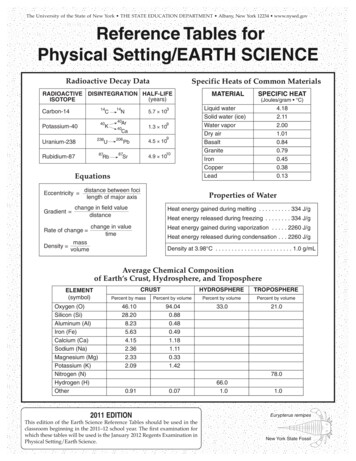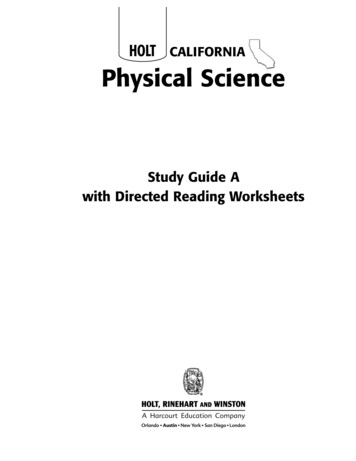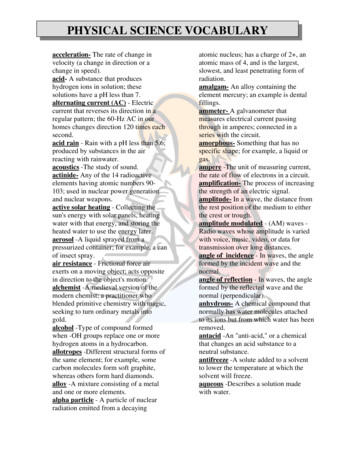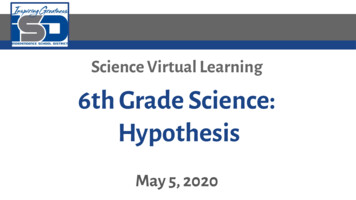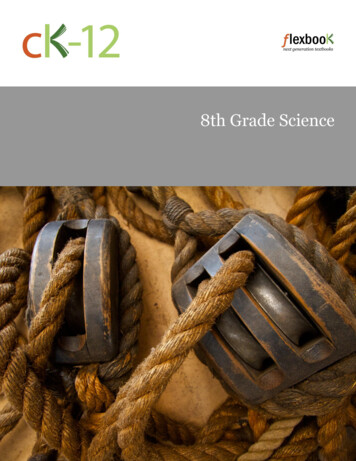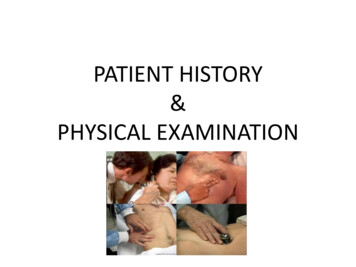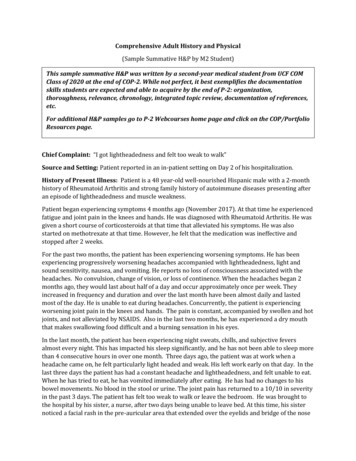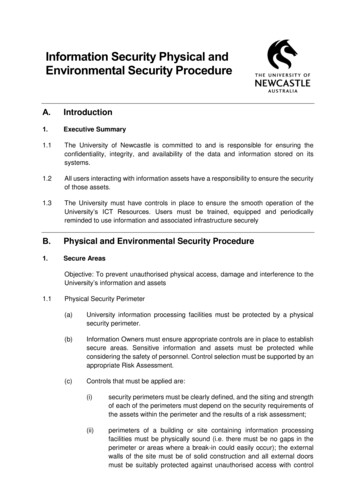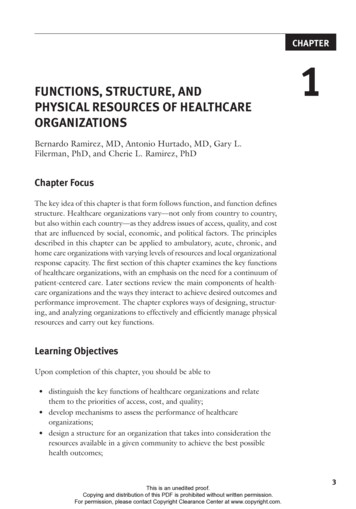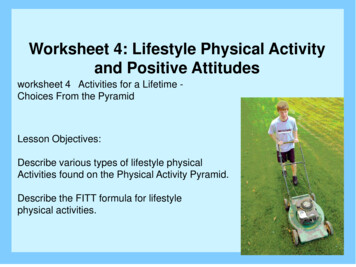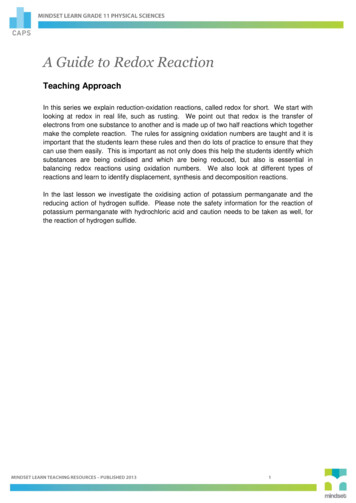
Transcription
A Guide to Redox ReactionTeaching ApproachIn this series we explain reduction-oxidation reactions, called redox for short. We start withlooking at redox in real life, such as rusting. We point out that redox is the transfer ofelectrons from one substance to another and is made up of two half reactions which togethermake the complete reaction. The rules for assigning oxidation numbers are taught and it isimportant that the students learn these rules and then do lots of practice to ensure that theycan use them easily. This is important as not only does this help the students identify whichsubstances are being oxidised and which are being reduced, but also is essential inbalancing redox reactions using oxidation numbers. We also look at different types ofreactions and learn to identify displacement, synthesis and decomposition reactions.In the last lesson we investigate the oxidising action of potassium permanganate and thereducing action of hydrogen sulfide. Please note the safety information for the reaction ofpotassium permanganate with hydrochloric acid and caution needs to be taken as well, forthe reaction of hydrogen sulfide.
Video SummariesSome videos have a ‘PAUSE’ moment, at which point the teacher or learner can choose topause the video and try to answer the question posed or calculate the answer to the problemunder discussion. Once the video starts again, the answer to the question or the rightanswer to the calculation is given.Mindset suggests a number of ways to use the video lessons. These include: Watch or show a lesson as an introduction to a lesson Watch or show a lesson after a lesson, as a summary or as a way of adding in someinteresting real-life applications or practical aspects Design a worksheet or set of questions about one video lesson. Then ask learners towatch a video related to the lesson and to complete the worksheet or questions, either ingroups or individually Worksheets and questions based on video lessons can be used as short assessments orexercises Ask learners to watch a particular video lesson for homework (in the school library or onthe website, depending on how the material is available) as preparation for the nextday’s lesson; if desired, learners can be given specific questions to answer inpreparation for the next day’s lesson1. Introduction to Redox ReactionsIn this lesson we introduce redox using real life examples. We explain that redoxreactions occur when there is a transfer of electrons between substances.2. Assigning Oxidation NumbersIn this lesson we go through the rules used to assign oxidation numbers and then usethese to determine the oxidation numbers in some examples.3. How to use Oxidation Numbers in Redox ReactionsIn this lesson we briefly revise the rules for assigning oxidation numbers. We explain thatredox reactions always involve changes in oxidation numbers.4. Various Types of Redox ReactionsIn this lesson we investigate various redox reactions. We use the reaction betweencopper and silver nitrate to show a displacement reaction.5. Using Oxidation Numbers to Balance Reaction EquationsIn this lesson we demonstrate how to balance equations using oxidation numbers byworking through an example step by step.6. Examples of Redox ReactionsIn this lesson the reducing action of hydrogen sulfide is shown by demonstrating anexperiment with hydrogen sulfide and potassium dichromate. Colour changes and theformation of a solid precipitate are pointed out.
Resource Material1. IntroductionReactions2. AssigningNumberstoRedoxOxidation3. How to use lesThis website gives everyexamples of redox ions.htmlThis page defines the concept ofoxidation-reduction s-in-real-lifeRedox reaction in real reactions-everydayexamplesRedox reactions everyday ns.htmlOxidation reduction s-in-real-lifeRedox reactions in real xidation com/watch?v lxEvuJPTvewA video on how to assign oxidationnumbers.http://www.youtube.com/watch?v PNaZqnFwIIQA videoreaction.http://www.youtube.com/watch?v Fz9eV-EWtpYA video on magnesium s/Development Details/xApproaches/VVV Demos/Burning MagnesiumBurning O3decomp05.pdfThe decomposition of potassiumchlorite.http://www.youtube.com/watch?v Fcr7UDHRa0YA You tube video on thedecomposition of potassium chlorite.http://people.ku.edu/ matt915/projects/chloratedecomp.htmlDecomposition of KCIO3.numbersonsingleanddayredoxreplacement
https://www.boundless.com/chemistr4. VariousTypesof y/aqueous-reactions/oxidation-Redox ReactionsThis page looks at the five maintypes of redox ons/http://www.youtube.com/watch?v Y5. UsingOxidation ZJt2TikFowNumbers to Balancehttp://www.youtube.com/watch?v Reaction EquationsBalancing reactions with oxidationnumber 1.A video on redox balancing.mvbPtQfAfUQ6. /chemequa.htmAdjustable 2 gas mixer.http://www.youtube.com/watch?v Tj5DMYgsW AA look at the reducing agents sulfurdioxide and hydrogen erties and uses of potassiumpermanganate (KMnO4).
TaskQuestion 1What is oxidation?Question 22.1 Determine the chemical that is oxidised in this reaction:4Fe 3O2 2Fe2O32.2 Determine the chemical that acts as the oxidising2Cu O2 2CuOagent in this reaction:Question 3State which substances are being oxidised.displacement reaction:3.1 Zn(s) H2SO4(aq) ZnSO4(aq) H2(g)3.2 4K(s) O2(g) 2K2O(s)Label the reaction as a synthesis orQuestion 4Use the rules for oxidation numbers to find the oxidation number of the atom indicated inbold:4.1 NH34.2 K2Cr2O74.3 Ca(OH)2Question 5Identify the chemicals that are oxidised and reduced in these reactions, and state thechange in their oxidation numbers.5.1 2Na(s) 2H2O(l) 2NaOH(aq) H2(g)5.2 2H2O CrO42- 3Fe(OH)2 CrO2- 3Fe(OH)3 OH-5.3Question 6Balance these equations using oxidation numbers2 6.1 NO2– MnO4– NO3– Mn6.2 Cl2(g) S2O32-(aq) Cl-(aq) SO42-(aq)
Task AnswersQuestion 1Oxidation is the loss of electrons.Question 22.1 Fe Fe , Fe has lost electrons and is therefore oxidised.22.2 The oxidising agent is reduced, which means that it gains electrons. O2 2O therefore oxygenis reduced and is the oxidising agent.3 Question 33.1 Zn(s) H2SO4(aq) ZnSO4(aq) H2(g)2 Zn Zn 2H H2Therefore the zinc is oxidised and the hydrogen is reduced.because the sulfate has exchanged ions.This is a displacement reaction3.2 4K(s) O2(g) 2K2O(s) K K therefore potassium is oxidised, which means that oxygen is reduced. This is asynthesis reaction since a new product, potassium oxide, is made by combining two substances.Question 44.1 NH3(Oxidation number of N) 3( 1) 0, therefore Oxidation number of N -34.2 K2Cr2O72( 1) 2(oxidation number of Cr) 7(-2 ) 0,therefore oxidation number of Cr 64.3 Ca(OH)2(oxidation number of Ca) 2(-1) 0 therefore oxidation number of Ca 2Question 55.1 0 1 -2 1 -2 102Na(s) 2H2O(l) 2NaOH(aq) H2(g)Sodium’s oxidation number changes from 0 to 1 so it is oxidised to sodium hydroxide.Hydrogen’s oxidation number changes from 1 to 0 so water is reduced to hydrogen gas.5.2 1 -2 6 -2 2 -2 1 3 -2 3 -2 1-2 122H2O CrO4 3Fe(OH)2 CrO2 3Fe(OH)3 Chromium’s oxidation number changes from 6 to 3 therefore it is reduced.Iron’s oxidation number goes from 2 to 3 therefore it is oxidised.Question 6--2 6.1 5 NO2 6 H 2 MnO4 5 NO3 2 Mn 3 H2O22 6.2 S2O3 (aq) 5 H20 4 Cl2(g) 2 SO4 (aq) 10 H (aq) 8 Cl (aq)OH-
AcknowledgementsMindset Learn Executive HeadContent Manager Classroom ResourcesContent Coordinator Classroom ResourcesContent AdministratorContent DeveloperContent ReviewersDylan BusaJenny LamontHelen RobertsonAgness MunthaliCandace RennieTara JonesLiz HarrisProduced for Mindset Learn by TrafficFacilities CoordinatorProduction ManagerDirectorEditorPresenterStudio CrewGraphicsCezanne ScheepersBelinda RenneyAlriette GibbsBelinda RenneyBanji LongweAbram TjaleJames TselapediWilson MthembuWayne dia/commons/6/6d/Rusty ons/6/66/EditorBBlackLeaves.jpgThis resource is licensed under a Attribution-Share Alike 2.5 South Africa licence. When usingthis resource please attribute Mindset as indicated at http://www.mindset.co.za/creativecommons
Task Answers Question 1 Oxidation is the loss of electrons. Question 2 2.1 Fe Fe3 , Fe has lost electrons and is therefore oxidised.

